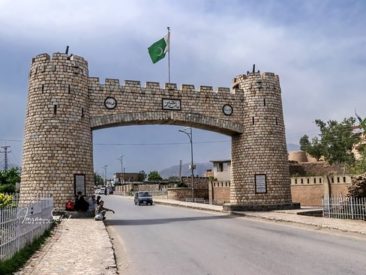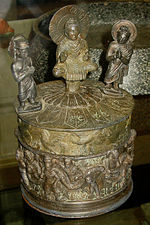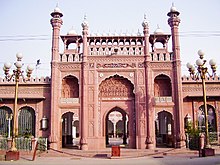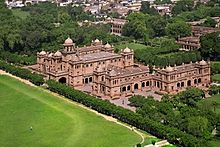Peshawar
Peshawar is the capital of the Pakistani province of Khyber Pakhtunkhwa. It also serves as the administrative centre and economic hub for the Federally Administered Tribal Areas.
Situated in a broad valley near the eastern end of the historic Khyber Pass, close to the border with Afghanistan, Peshawar’s recorded history dates back to at least 539 BCE, making it the oldest city in Pakistan and one of the oldest in South Asia.Peshawar was the capital of the ancient Kushan Empire, and was home to what may have been the tallest building in the ancient world, the Kanishka stupa.Peshawar was then sacked by the White Huns, before the arrival of Muslim empires. The city was an important trading centre during the Mughal era before serving as capital for the Durrani Afghan Empire.
The city of Peshawar has a population of 1,970,042 according to the 2017 census, making it the largest city in Khyber Pakhtunkhwa and the sixth-largest in Pakistan, while Peshawar District has a population of 4,269,079.
Ancient
Founding
Peshawar was founded as the ancient city of Puruṣapura,on the Gandhara Plains in the broad Valley of Peshawar. The city likely first existed as a small village in the 5th century BCE, within the cultural sphere of eastern ancient Persia. Puruṣapura was founded near the ancient Gandharan capital city of Pushkalavati, near present-day Charsadda.
Greek
In the winter of 327–26 BCE, Alexander the Great subdued the Valley of Peshawar during his invasion of ancient India,as well as the nearby Swat and Buner valleys.Following Alexander’s conquest, the Valley of Peshawar came under suzerainty of Seleucus I Nicator, founder of the Seleucid Empire. A locally-made vase fragment that was found in Peshawar depicts a scene from Sophocles’ play Antigone.
Mauryan
The nearby Takht-i-Bahi monastery was established in 46 CE, and was once a major centre of Buddhist learning.
Following the Seleucid–Mauryan war, the region was ceded to the Mauryan Empire in 303 BCE.Around 300 BCE, the Greek diplomat and historian Megasthenes noted that ancient Peshawar was the western terminus of a Mauryan road that connected the city to the empire’s capital at Pataliputra,near the city of Patna in the modern-day Indian state of Bihar.
As Mauryan power declined, the Greco-Bactrian Kingdom based in modern Afghanistan declared its independence from the Seleucid Empire, and quickly seized ancient Peshawar around 190 BCE. The city was then ruled by several Iranic Parthian kingdoms. The city was then captured by Gondophares, founder of the Indo-Parthian Kingdom. Gondophares established the nearby Takht-i-Bahi monastery in 46 CE.
Kushan
Perhaps the tallest building in the ancient world, Peshawar’s Kanishka stupa once kept sacred Buddhist relics in the Kanishka casket.
In the first century of the Common era, ancient Peshawar came under control of Kujula Kadphises, founder of the Kushan Empire. The city was made the empire’s winter capital. The Kushan’s summer capital at Kapisi(modern Bagram, Afghanistan) was seen as the secondary capital of the empire, while Puruṣapura was considered to be the empire’s primary capital.Ancient Peshawar’s population was estimated to be 120,000, which would make it the seventh-most populous city in the world at the time.
Around 128 CE, ancient Peshawar was made sole capital of the Kushan Empire under the rule of Kanishka.As a devout Buddhist, the emperor built the grand Kanishka Mahavihara monastery. After his death the magnificent Kanishka stupa was built in Peshawar to house Buddhist relics. The golden age of the Kushan empire in Peshawar ended in 232 CE with the death of the last great Kushan king, Vasudeva I.
Around 260 CE, the armies of the Sasanid Emperor Shapur I launched an attack against Peshawar, and severely damage Buddhist monuments and monasteries throughout the Valley of Peshawar. Shapur’s campaign also resulted in damage to the city’s monumental stupa and monastery. The Kushans were made subordinate to the Sasanids, and their power rapidly dwindled, as the Sasanids blocked lucrative trade routes westward out of Puruṣapura.
Kushan Emperor Kanishka III was able to temporarily reestablish control over the entire Valley of Peshawar after Shapur’s invasion, but the city was then captured by the Central Asian Kidarite kingdom in the early 400s CE.
White Huns
The White Huns devastated ancient Peshawar in the 460s CE, and ravaged the entire region of Gandhara, destroying its numerous monasteries. The Kanishka stupa was rebuilt during the White Hun era with the construction of a tall wooden superstructure, built atop a stone base,and crowned with a 13-layer copper-gilded chatra. In the 400s CE, the Chinese Buddhist pilgrim Faxian visited the structure and described it as “the highest of all the towers” in the “terrestrial world”, which ancient travelers claimed was up to 560 feet (170 m) tall, though modern estimates suggest a height of 400 feet (120 m).
In 520 CE the Chinese monk Song Yun visited Gandhara and ancient Peshawar during the White Hun era, and noted that it was in conflict with nearby Kapisa.The Chinese monk and traveler Xuanzang visited ancient Peshawar around 630 CE, after Kapisa victory, and expressed lament that the city and its great Buddhist monuments had decayed to ruin — although some monks studying Hinayana Buddhism continued to study at the monastery’s ruins.Xuanzang estimated that only about 1,000 families continued in a small quarter among the ruins of the former grand capital.
Early Islamic
Until the mid 7th century, the residents of ancient Peshawar are believed to have been primarily ancient-Indians,with a ruling elite of Central Asian Scythian descent,who were then displaced by the Hindu Shahis of Kabul.
Islam is believed to have been first introduced to the Buddhist and Zoroastrian inhabitants of Puruṣapura in the later 7th century.
As the first Pashtun tribe to settle the region, the Dilazak Pashtuns began settling in the Valley of Peshawar, and are believed to have settled regions up to the Indus River by the 11th century. The Arab historian and geographer Al-Masudi noted that by the mid 10th century, the city had become known as Parashāwar.
In 986–87 CE, Peshawar’s first encounter with Muslim armies occurred when Sabuktigin invaded the area and fought the Hindu Shahis under their king, Anandpal.
Medieval
On November 28, 1001, Sabuktigin’s son Mahmud Ghazni decisively defeated the army of Raja Jayapala, son of Anandpal, at the Battle of Peshawar, and established rule of the Ghaznavid Empire in the Peshawar region.
During the Ghaznavid era, Peshawar served as an important stop between the Afghan plateau, and the Ghaznavid garrison city of Lahore. During the 10th–12th century, Peshawar served as a headquarters for Hindu Nath Panthi Yogis, who in turn are believed to have extensively interacted with Muslim Sufi mystics.
In 1179–80, Muhammad Ghori captured Peshawar, though the city was then destroyed in the early 1200s at the hands of the Mongols.Peshawar was an important regional centre under the Lodi Empire.
The Khashi Khel Pashtuns, ancestors of modern-day Yusufzai and Gigyani Pashtuns, began settling rural regions around Peshawar in the late 1400s.The Khashi Khel tribe pushed the Dilazak Pashtun tribes east of the Indus River following a battle in 1515 near the city of Mardan.
Mughal
Bestowed by Mohabbat Khan bin Ali Mardan Khan in 1630, the white-marble façade of the Mohabbat Khan Mosque is one of Peshawar’s most iconic sights.
The interior of the Mohabbat Khan Mosque is elaborately frescoed with elegant and intricately detailed floral and geometric motifs.
Peshawar remained an important centre on trade routes between India and Central Asia. The Peshawar region was a cosmopolitan region in which goods, peoples, and ideas would pass along trade routes. Its importance as a trade centre is highlighted by the destruction of over one thousand camel-loads of merchandise following an accidental fire at Bala Hissar fort in 1586.Mughal rule in the area was tenuous, as Mughal suzerainty was only firmly exercised in the Peshawar valley, while the neighbouring valley of Swat was under Mughal rule only during the reign of Akbar.
In July 1526, Emperor Babur captured Peshawar from Daulat Khan Lodi.Babur is said to have renamed the city Begram, and rebuilt the city’s fort. Babur used the city as a base for expeditions to nearby Kohat and Bannu.
Under the reign of Babur’s son, Humayun, direct Mughal rule over the city was briefly challenged with the rise of the Pashtun king, Sher Shah Suri, who began construction of the famous Grand Trunk Road in the 16th century. Peshawar was an important trading centre on Sher Shah Suri’s Grand Trunk Road.
Akbar renamed Begram to Peshawar;perhaps derived from the Persian “pīsh shehr” (پیش شهر) – meaning “forward city”, in reference to the city’s frontier status. In 1586, Pashtuns rose against Mughal rule during the Roshaniyya Revolt under the leadership of Pir Roshan,founder of the egalitarian Roshaniyyas, who shut down trade routes out of Peshawar, and laid siege to the city until 1587.
Peshawar was bestowed with its own set of Shalimar Gardens during the reign of Shah Jahan, which no longer exist.
Emperor Aurangzeb‘s Governor of Kabul, Mohabbat Khan bin Ali Mardan Khan used Peshawar as his winter capital during the 17th century, and bestowed the city with its famous Mohabbat Khan Mosque in 1630.
Yusufzai tribes rose against Mughal rule during the Yusufzai Revolt of 1667, and engaged in pitched-battles with Mughal battalions nearby Attock. Afridi tribes resisted Mughal rule during the Afridi Revolt of the 1670s. The Afridis massacred a Mughal battalion in the nearby Khyber Pass in 1672 and shut the pass to lucrative trade routes. Mughal armies led by Emperor Aurangzeb himself regained control of the entire area in 1674.
Following Aurangzeb’s death in 1707, his son Bahadur Shah I, former Governor of Peshawar and Kabul, was selected to be the Mughal Emperor. As Mughal power declined following the death of Emperor Aurangzeb, the empire’s defenses were weakened.
Afsharid
On 18 November 1738, Peshawar was captured from the Mughal governor Nawab Nasir Khan by the Afsharid armies during the Persian invasion of the Mughal Empire under Nader Shah.
Durrani Afghans
Peshawar’s Bala Hissar fort was once the royal residence of the Durrani Afghan kings.
In 1747, Peshawar was taken by Ahmad Shah Durrani, founder of the Afghan Durrani Empire. Under the reign of his son Timur Shah, the Mughal practice of using Kabul as a summer capital and Peshawar as a winter capital was reintroduced, with the practice maintained until the Sikh invasion. Peshawar’s Bala Hissar Fort served as the residence of Afghan kings during their winter stay in Peshawar. Peshawar was attacked and briefly held by the Marathas, which conquered the city in the Battle of Peshawar in May 1758. A large force of Pashtuns under the Durrani then re-conquered Peshawar in early 1759. Peshawar was noted to be the main centre of trade between Bukhara and India by British explorer William Moorcroft during the late 1700s. Peshawar was at the centre of a productive agricultural region that provided much of north India’s dried fruit.
Timur Shah’s grandson, Mahmud Shah Durrani, became king, and quickly seized Peshawar from his half-brother, Shah Shujah Durrani.Shah Shujah was then himself proclaimed king in 1803, and recaptured Peshawar while Mahmud Shah was imprisoned at Bala Hissar fort until his eventual escape. In 1809, the British sent an emissary to the court of Shah Shujah in Peshawar, marking the first diplomatic meeting between the British and Afghans. His half-brother Mahmud Shah then allied himself with the Barakzai Pashtuns, and captured Peshawar once again and reigned until 1818.
Sikh
Ranjit Singh invaded Peshawar in 1818 and captured it from the Durranis. The Sikhs soon lost control, and so in 1823, Ranjit Singh returned to battle the armies of Azim Khan at Nowshera. Following the Sikh victory at the Battle of Nowshera, Ranjit Singh re-captured Peshawar.By 1830, Peshawar’s economy was noted by Scottish explorer Alexander Burnes to have sharply declined,with Ranjit Singh’s forces having destroyed the city’s palace and agricultural fields.
Much of Peshawar’s caravan trade from Kabul ceased on account of skirmishes between Afghan and Sikh forces, as well as a punitive tax levied on merchants by Ranjit Singh’s forces.Singh’s government also required Peshawar to forfeit much of its leftover agricultural output to the Sikhs as tribute, while agriculture was further decimated by a collapse of the dried fruit market in north India.Singh appointed Neapolitan mercenary Paolo Avitabile as administrator of Peshawar, who is remembered for having unleashed a reign of terror. His time in Peshawar is known as a time of “gallows and gibbets.” The city’s famous Mahabat Khan, built in 1630 in the Jeweler’s Bazaar, was badly damaged and desecrated by the Sikh conquerors.
The Sikh Empire formally annexed Peshawar in 1834 following advances from the armies of Hari Singh Nalwa— bringing the city under direct control of the Sikh Empire’s Lahore Durbar. An 1835 attempt by Dost Muhammad Khan to re-occupy the city failed when his army refused to engage in combat with the Dal Khalsa. Sikh settlers from Punjab were settled in the city during Sikh rule. The city’s only remaining Gurdwaras were built by Hari Singh Nalwa to accommodate the newly-settle Sikhs. The Sikhs also rebuilt the Bala Hissar fort during their occupation of the city.
British Raj
The British-era Islamia College was built in an Indo-Saracenic Revival style.
Built for wealthy local merchants in a Central Asian architectural style, the Sethi Mohallah features several homes dating from the British era.
Following the defeat of the Sikhs in the Second Anglo-Sikh War in 1849, territories in the Punjab were also captured by the British East India Company. The British for re-established stability in the wake of ruinous Sikh rule. During the Sepoy Rebellion of 1857, the 4,000 members of the native garrison were disarmed without bloodshed; the absence of brutality meant that Peshawar was not affected by the widespread devastation that was experienced throughout the rest of British India and local chieftains sided with the British after the incident.
The British laid out the vast Peshawar Cantonment to the west of the city in 1868, and made the city its frontier headquarters.Additionally, several projects were initiated in Peshawar, including linkage of the city by railway to the rest of British India and renovation of the Mohabbat Khan mosque that had been desecrated by the Sikhs. British suzerainty over regions west of Peshawar was cemented in 1893 by Sir Mortimer Durand, foreign secretary of the British Indian government, who collaboratively demarcated the border between British controlled territories in India and Afghanistan.
The British built Cunningham clock tower in celebration of the Golden Jubilee of Queen Victoria, and in 1906 built the Victoria Hall (now home of the Peshawar Museum) in memory of Queen Victoria. The British introduced Western-style education ito Peshawar with the establishment of Edwardes College and Islamia College in 1901 and 1913, along with several schools run by the Anglican Church.For better administration of the region, Peshawar and the adjoining districts were separated from the Punjab Province in 1901, after which Peshawar became capital of the new province.
Edwardes College was built during the British-era, and is now one of Peshawar’s most prestigious educational institutions.
Peshawar emerged as a centre for both Hindko and Pashtun intellectuals during the British era. Hindko speakers, also referred to as Khaarian (“city dwellers” in Pashto), were responsible for the dominant culture for most of the time that Peshawar was under British rule.Peshawar was also home to a non-violent resistance movement led by Ghaffar Khan, a disciple of Mahatma Gandhi. In April 1930, Khan led a large group of Khan’s followers protested in Qissa Khawani Bazaar against discriminatory laws that had been enacted by the British rulers — hundreds were killed when British troops opened fire on the demonstrators.
Modern era
In 1947, Peshawar became part of the newly created state of Pakistan, and emerged as a cultural centre in the country’s northwest. The University of Peshawar was established in the city in 1950, and augmented by the amalgamation of nearby British-era institutions into the university. Until the mid-1950s, Peshawar was enclosed within a city wall and sixteen gates. In the 1960s, Peshawar was a base for a CIA operation to spy on the Soviet Union, with the 1960 U-2 incident resulting aircraft an aircraft flown from Peshawar was shot down by the Soviets. From the 1960s until the late 1970s, Peshawar was a major stop on the famous Hippie trail.
During the Soviet war in Afghanistan in the 1980s, Peshawar served as a political centre for the CIA and the Inter-Services Intelligence-trained mujahideen groups based in the camps of Afghan refugees. It also served as the primary destination for large numbers of Afghan refugees. By 1980, 100,000 refugees a month were entering the province, with 25% of all refugees living in Peshawar district in 1981.The arrival of large numbers of Afghan refugees strained Peshawar’s infrastructure, and drastically altered the city’s demography.
Like much of northwest Pakistan, Peshawar has been severely affected by violence from the attacks of the extremist Taliban. Local poets’ shrines have been targeted by the Pakistani Taliban, a suicide bomb attack targeted the historic All Saints Church, and most notably the 2014 Peshawar school massacre in which Taliban militants killed 132 school children.
Peshawar suffered 111 acts of terror in 2010, which had declined to 18 in 2014, before the launch of Operation Zarb-e-Azb which has further reduced acts of violence throughout Pakistan. More civilians died in acts of violence in 2014 compared to 2010 – largely a result of the Peshawar school massacre.
Geography
The city serves as a gateway to the Khyber Pass, whose beginning is marked by the Khyber Gate.
Topography
Peshawar sits at the eastern end of the Khyber Pass, which has been used as a trade route since the Kushan era approximately 2000 years ago.
Peshawar is located in the broad Valley of Peshawar, which is surrounded by mountain ranges on three sides, with the fourth opening to the Punjab plains. The city is located in the generally level base of the valley, known as the Gandhara Plains.
Climate
With an influence from the local steppe climate, Peshawar features a hot semi-arid climate (Köppen BSh), with hot summers and cool winters. Winter in Peshawar starts in November and ends in late March, though it sometimes extends into mid-April, while the summer months are from mid-May to mid-September. The mean maximum summer temperature surpasses 40 °C (104 °F) during the hottest month, and the mean minimum temperature is 25 °C (77 °F). The mean minimum temperature during the coolest month is 4 °C (39 °F), while the maximum is 18.3 °C (64.9 °F).
Peshawar is not a monsoon region, unlike other parts of Pakistan; however, rainfall occurs in both winter and summer. Due to western disturbances, the winter rainfall shows a higher record between the months of February and April. The highest amount of winter rainfall, measuring 236 millimetres (9.3 in), was recorded in February 2007,while the highest summer rainfall of 402 millimetres (15.8 in) was recorded in July 2010; during this month, a record-breaking rainfall level of 274 millimetres (10.8 in) fell within a 24-hour period on 29 July 2010 — the previous record was 187 millimetres (7.4 in) of rain, recorded in April 2009. The average winter rainfall levels are higher than those of summer. Based on a 30-year record, the average annual precipitation level was recorded as 400 millimetres (16 in) and the highest annual rainfall level of 904.5 millimetres (35.61 in) was recorded in 2003. Wind speeds vary during the year, from 5 knots(5.8 mph; 9.3 km/h) in December to 24 knots (28 mph; 44 km/h) in June. The relative humidity varies from 46% in June to 76% in August. The highest temperature of 50 °C (122 °F) was recorded on 18 June 1995, while the lowest −3.9 °C (25.0 °F) occurred on 7 January 1970.












